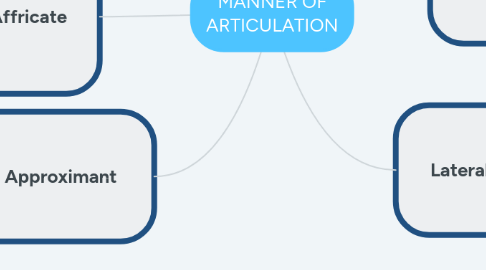
1. Nasal
1.1. Are created when you completely block the flow of air through your mouth and allow air to pass through your nose.
1.1.1. Example: /m/ - "mad" and "clam" /n/ - "no" and "man" . /ŋ/ - "going" and "funk"
2. Stop
2.1. Stop consonants occur when the vocal tract closes completely. the air rapidly increases the load behind the articulators and then is released in a burst.
2.1.1. Example: /p/ - "rap" /b/ - "cab" /t/ - "rat"
3. Lateral
3.1. Lateral consonants are generated if the tongue prevents access to the center of the mouth and air has to circulate through the sides.
3.1.1. Example: /l/ - "lucky" -
4. Fricative
4.1. Fricative sounds involve only a closure of the vocal tract, so air has to be propelled through a limited channel.
4.1.1. Example: /f/ - "fro" and "calf". /v/ - "vine" and "have"
5. Affricate
5.1. They are the combination of fricative and stop consonants, they start as stop sounds with air accumulated behind an articulator which is then released through a narrow channel as a fricative.
5.1.1. Example: /tʃ/ - "chick" and "match" /dʒ/ - "jam" and "badge"
6. Approximant
6.1. Approximations are made in the case where two articulators are placed close together, but not close enough to generate air vortices.
6.1.1. /w/ - "wet" and "Howard" /j/ - "yes" and "bayou"
7. PLACE OF ARTICULATION
7.1. Bilabial
7.1.1. Bilabial consonants are formed when airflow out of the mouth is restricted by joining the lips together.
7.1.1.1. Example: /p/ as in "purse" and "rap". /b/ as in "back" and "cab". /m/ as in "mad" and "clam".
7.2. Labio-Dental
7.2.1. Labiodental consonants are formed when the airflow is blocked by curving the lower lip back and lifting it up to touch the upper row of teeth.
7.2.1.1. /f/ as in "fro" and "calf". /v/ as in "vine" and "have".
7.3. Dental
7.3.1. Dental consonants are produced when airflow is blocked by placing the sliding tongue against the upper teeth
7.3.1.1. Example: /θ/ as in "thick" and "bath". /ð/ as in "the" and "rather".
7.4. Alveolar
7.4.1. Alveolar consonants are created when the tongue rises toward the alveolar ridge to impede or restrict the passage of air.
7.4.1.1. /n/ as in "no" /t/ as in "tab /d/ as in "dip /s/ as in "suit" /s/ as in "suit /z/ as in "zit" /l/ as in "luck /l/ as in "luck" /l/ as in "luck
7.5. Post-Alveolar
7.5.1. When the tongue withdraws slightly from the alveolar ridge, the sounds are modified enough to be considered consonants.
7.5.1.1. Example: /ʃ/ as in "shot" or "brash". /ʒ/ as in "vision" or "measure". /tʃ/ as in "chick" or "match". /dʒ/ as in "jam" or "badge".
7.6. Palatal
7.6.1. Palatal consonants are created when the tongue is raised to this point and airflow is restricted.
7.6.1.1. example /j/ as in "yes" and "bayou".
7.7. Velar
7.7.1. Velar consonants are produced when the back of the tongue rises toward the velum to block or restrict airflow.
7.7.1.1. Example: /ŋ/ as in "go." /k/ as in "kite" and "back". /g/ as in "good" and "bug". /w/ as in "wet" and "howard".
7.8. Glottal
7.8.1. Glottal consonants are not really consonants; they only serve consonantal functions in the language
7.8.1.1. example /h/ as in "hi" and "Bahamas." /t/ as in "what".
